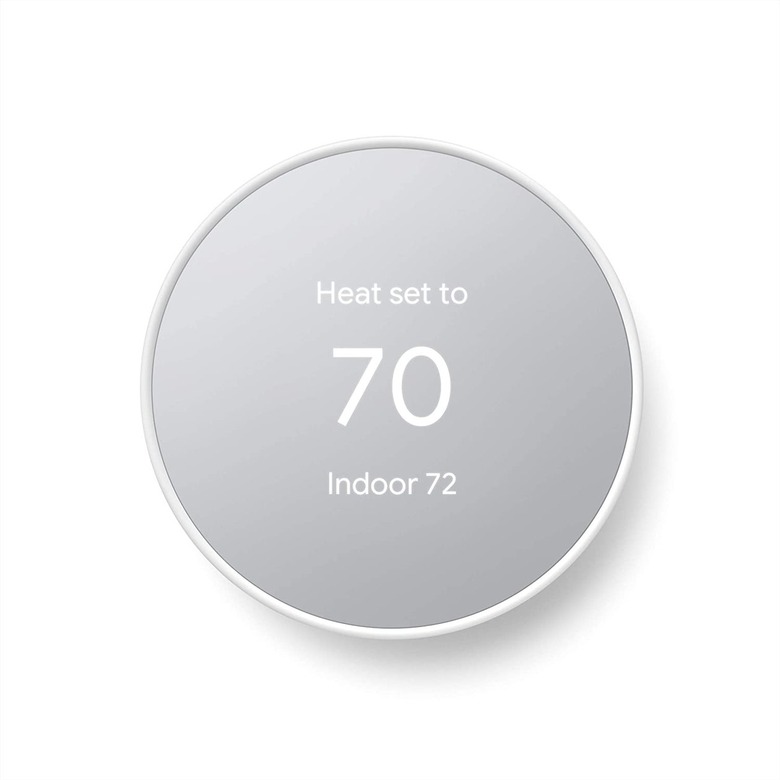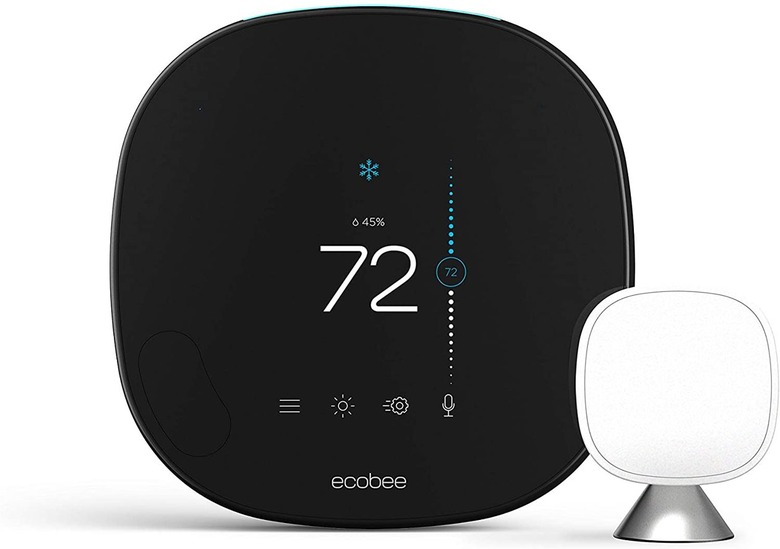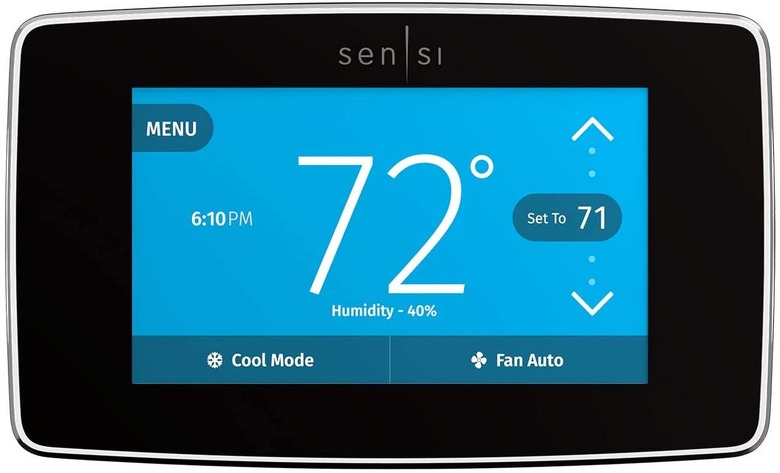Buying A Smart Thermostat? Here's What You Need To Know
We may receive a commission on purchases made from links.
The first smart thermostat was launched in 2007 by Ecobee — now, the market includes dozens of options and greater functionality than ever before. Promising a reduction in energy use and subsequent utility bills while maximizing convenience, smart thermostats communicate with your smart devices or home hub through Wi-Fi and/or z-wave technology so you don't have to get off the couch — or even be at home — to adjust the temperature. When you're researching different smart thermostats, pay attention to compatibility first, functionality second and price third.
How Smart Thermostats Work
How Smart Thermostats Work
All smart thermostats require a Wi-Fi connection and a smartphone for full functionality. They can be programmed and controlled via a smartphone app, allowing you to adjust your home's temperature even when you aren't there. They can also be programmed for a variety of conditions beyond the typical time windows available on standard programmable thermostats. For example, some smart thermostats also have the ability to detect whether you're home or not and will adjust the temperature according to your "away" preferences.
All smart thermostats feature a display screen so you can make adjustments from the thermostat itself. Some pair with smart home hubs for voice control too. However, full functionality requires a smartphone app, which differs for every product. Smart thermostats will also continue to heat and cool your home without a Wi-Fi connection but will lose certain functions, like the "away" feature and voice control.
Benefits of Smart Thermostats
Benefits of Smart Thermostats
Part of the allure of smart thermostats lies in their potential energy savings. Your home doesn't need to be perfectly comfortable when no one's around, so you can program a smart thermostat to remain off during the day and kick on about an hour before you get home. This can add up to 8 percent savings on annual heating and cooling, which translates to about $50 per year for most homeowners. Standard programmable thermostats let you do the same thing, so what's so special about smart thermostats?
Convenience and flexibility are where smart thermostats shine. If you don't have a predictable schedule, smart thermostats let you turn the system on and off whenever you're ready. If you're a new parent and have a baby sleeping on your chest but you're dying to turn down the thermostat, you can accomplish it silently through your phone. Maybe your parents are getting a little less mobile and would like to add, "Alexa, cool down the thermostat!" to their list of voice commands.
Some of the latest models sense when you're home so you don't even have to remember to say anything or get out your phone. It's exciting to explore all the different options, but don't forget to pin down a few practical must-haves, like system compatibility, before you click "Add to Cart."
HVAC System Compatibility
HVAC System Compatibility
Most smart thermostats work with low-voltage (24v) HVAC systems, including gas or electric furnaces. Look for several clues that point to a low-voltage system: Just one thermostat powers your entire house; your home uses a central furnace for heat; or thin, multicolored wires connect to the back of your old thermostat. You should have no problem finding a smart thermostat compatible with this system.
If you have separate thermostats or heating units for each room in your home, don't have a central furnace or see thick red and black wires behind your existing thermostat, you probably have a line voltage system. You can still purchase smart thermostats for this thermostat wiring, but the options will be limited. Try the Mysa smart thermostat for electric baseboard heaters, electric fan-forced heaters or electric in-floor heating, for example.
Another frequent compatibility concern involves a specific wire called a C-wire, or common wire, which runs from the thermostat to the HVAC system to provide the thermostat with continuous power. If you don't already have a C-wire connected to your thermostat, it's not necessarily a deal breaker since the other wires also provide some power. However, you might need an electrician for thermostat installation, as they'll need to install a C-wire if you experience frequent thermostat shutdowns, Wi-Fi disconnections, etc.
Smart Home Hub Compatibility
Smart Home Hub Compatibility
One of the perks of a smart thermostat is the ability to control it with voice commands via your smart home hub (if you have one; they're sold separately from smart thermostats). Many smart thermostat manufacturers understand the value of making products compatible with as many home hubs as possible, but you'll still encounter some thermostat options that only work with a specific hub. Whether you have Google Assistant, Amazon Alexa or Samsung SmartThings, verify compatibility before you buy a new smart thermostat.
Do you want voice control but don't have a home hub? Some smart thermostats include built-in voice control. For example, the Ecobee SmartThermostat with voice control has Amazon Alexa built in.
Total Hands-Off Functionality
Total Hands-Off Functionality
Some people prefer to adjust their thermostats, and others just want to set it and forget it forever. If you fall into the latter category, try a learning thermostat — or rather, try the learning thermostat, since there's only one currently on the market: the Google Nest learning thermostat.
This ultra-smart thermostat not only includes temperature sensors but also motion and light sensors to determine whether you're home or not. It also connects to the internet to collect real-time weather data. The Google Nest learning thermostat evaluates all of this data and automatically adjusts the temperature inside your home for maximum energy efficiency and comfort. You only have to set the temperature once after initial installation.
Smart Thermostats With Geofencing Technology
Smart Thermostats With Geofencing Technology
The Google Nest learning thermostat is an industry game-changer, but it's not the only thermostat that can detect whether or not you're home. Others use geofencing technology, which basically determines whether your smartphone is located within range of the thermostat. These thermostats will automatically switch to your desired "away" temperature when you go out of range.
This system does have some drawbacks. If you end up spending all day outside in the yard, it may not adjust the indoor temperature because it senses you're still nearby. It also requires you to keep certain phone settings activated, including Wi-Fi, general location services and background mobile app refresh. You'll also need to disable the geofence feature if you have guests over (or add them as users) to keep the house cozy when you're not home.
Smart thermostats with geofencing capabilities include Google Nest, Ecobee, Emerson Sensi and Lux Kono.
Remote Temperature Sensors
Remote Temperature Sensors
All thermostats include a temperature sensor that cues the HVAC system to turn on or off, but the temperature sensed by the thermostat isn't necessarily the temperature of every room in the home. The upstairs bedrooms might still be too hot, or the family room in the basement might be too cold.
By placing extra sensors in these rooms, the smart thermostat uses multiple temperature readings to determine when to turn the HVAC system on or off, and every room in the home should stay around the same temperature as a result. If a balanced temperature is one of your priorities, choose a smart thermostat with remote temperature sensor add-ons. (For even better results, install dampers in your vents.)
References
- iMore.com: Nest Thermostat vs Nest Learning Thermostat: Differences and Which Should You Buy?
- Smart Thermostat Guide: What Is Geofencing and How Do Smart Thermostats Use It?
- Google Nest Help: Learn About the Common or C Wire
- ENERGY STAR: ENERGY STAR Ends the Thermostat Wars by Introducing First-Ever Smart Thermostat Specification


